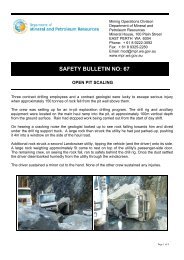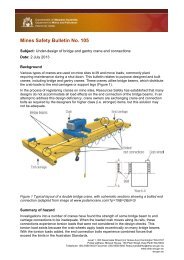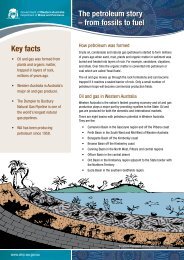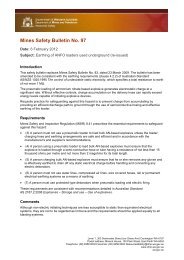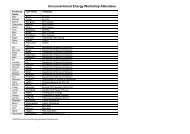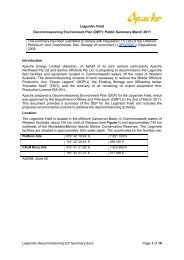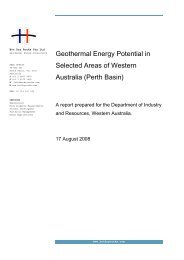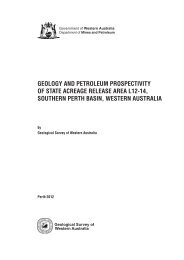Phase III - Department of Mines and Petroleum
Phase III - Department of Mines and Petroleum
Phase III - Department of Mines and Petroleum
You also want an ePaper? Increase the reach of your titles
YUMPU automatically turns print PDFs into web optimized ePapers that Google loves.
Data Well should also be incorporated into such an integrated report. Further reservoir quality assessment<br />
is strongly recommended using the total core analysis dataset, thin section <strong>and</strong> quantitative XRD data.<br />
More advanced petrographic analyses could also include stable isotope analysis <strong>of</strong> carbonate cements, to<br />
confirm the origin for siderite cement.<br />
We strongly recommend that further studies are undertaken to better underst<strong>and</strong> the depositional setting<br />
<strong>and</strong> the differences between different units (BD, LD, UMS, <strong>and</strong> UD). Existing sedimentology, ichnology,<br />
FMI <strong>and</strong> palynology reports, preferably with a new study <strong>of</strong> benthic foraminifera, should be integrated. It<br />
is recommended that the existing log correlations are reviewed in light <strong>of</strong> data from the Data Well. A<br />
sequence stratigraphic approach to the correlation is suggested, possibly following the development <strong>of</strong> logfacies<br />
interpretations, which should be integrated with seismic interpretations. We recommend that<br />
detailed log correlation is attempted as part <strong>of</strong> an integrated log-correlation-biostratigraphic study. Revised<br />
paleogeographic maps should be generated for each <strong>of</strong> the major intervals, <strong>and</strong> we strongly recommend that<br />
variogram parameters be reviewed, <strong>and</strong> as appropriate modified, following the recommended integrated<br />
study <strong>of</strong> depositional systems in the Dupuy <strong>and</strong> suitable analogue data. Models should be run with a range<br />
<strong>of</strong> variograms to capture uncertainties in facies, <strong>and</strong> sensitivities in the model documented. The use <strong>of</strong><br />
planned sensitivity testing <strong>of</strong> the static model <strong>and</strong> construction <strong>of</strong> a new suite <strong>of</strong> post-Data Well static <strong>and</strong><br />
dynamic models is endorsed. The GJV plan to obtain laboratory measurements <strong>of</strong> relative permeability <strong>and</strong><br />
we strongly recommend that the results from special core analyses, including the assessment <strong>of</strong><br />
dehydration, skin factor, <strong>and</strong> fines release from core-floods, be incorporated in the reservoir simulation<br />
model. We maintain that either a depositional facies scheme or a more detailed petrophysical facies<br />
scheme ought to be developed, which should result in a better underst<strong>and</strong>ing <strong>of</strong> the Dupuy Formation<br />
beneath Barrow Isl<strong>and</strong>.<br />
Further interrogation <strong>of</strong> the flow unit transforms is strongly recommended in association with petrographic<br />
analyses <strong>and</strong> quantitative XRD results, to better define, flow zones for permeability assessment. While the<br />
GJV have indicated that this interrogation is underway, we recommend it includes further evaluation <strong>of</strong><br />
wireline log responses, computed logs <strong>and</strong> FZI zonation in relation to thin section, SEM <strong>and</strong> XRD<br />
petrography <strong>of</strong> s<strong>and</strong>stones, seals <strong>and</strong> baffles, reservoir quality <strong>and</strong> sedimentary facies. Horizontal <strong>and</strong><br />
vertical permeability should also be interrogated by formation, lith<strong>of</strong>acies <strong>and</strong> facies to better underst<strong>and</strong><br />
vertical permeability trends, necessary for more accurate reservoir models.<br />
Three dimensional seismic reflection <strong>and</strong> drill-hole information indicate that faults <strong>and</strong> fractures are present<br />
in the Dupuy reservoir <strong>and</strong> the strata that overlie it. We strongly recommend that all seismically resolvable<br />
faults (including lineaments within the seismic volume considered by the Due Diligence Team to probably<br />
be faults) are interpreted to their tip lines. These interpreted faults <strong>and</strong> predicted sub-seismic faults with<br />
throws <strong>of</strong> ≥ 5m should be incorporated into the static model. In addition, a detailed analysis <strong>of</strong> fractures in<br />
all available core <strong>and</strong> FMI data (include review <strong>of</strong> differences in two FMI reports) should be undertaken.<br />
To augment existing fracture data multi-azimuth walkaways are recommended to effectively deploy some<br />
<strong>of</strong> the seismic analytical techniques outlined for fracture detection.<br />
The choice <strong>of</strong> specific reservoir simulation codes is not considered by the Due Diligence Team to be as<br />
important as the quality <strong>of</strong> the PVT data used in the models <strong>and</strong> the quality <strong>of</strong> the underlying geological<br />
model. However, we do recommend that reservoir simulation models be calibrated by history matching <strong>of</strong><br />
monitoring data as such data is obtained. Furthermore, the GJV are urged to consider models which are<br />
able to couple fluid flow, geomechanics <strong>and</strong> geochemistry.<br />
Geomechanical analysis has been undertaken to determine how the Dupuy reservoir <strong>and</strong> overlying rocks<br />
will respond to the injection <strong>of</strong> CO 2 . To calculate critical instantaneous delta pressures, which provide<br />
information on fault stability, we strongly recommend a conservative approach is adopted <strong>and</strong> that the<br />
minimum reasonable value for fault sliding friction (e.g., 0.7) is used. Fault analysis should also include a<br />
re-examination <strong>of</strong> the potential for injection induced slip on the Main Barrow fault (including the impact <strong>of</strong><br />
dynamic rupture processes) <strong>and</strong> a review <strong>of</strong> the impact <strong>of</strong> slip on hydrocarbon resources adjacent to the<br />
fault. To further improve underst<strong>and</strong>ing <strong>of</strong> how the post-injection reservoir conditions have been<br />
determined, the complete methodology for computing S hmin together with constraints used to compute the<br />
distribution <strong>of</strong> S hmin should be documented. Estimates <strong>of</strong> reservoir stress conditions should be augmented<br />
xxxvii



